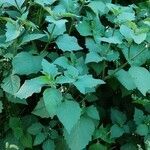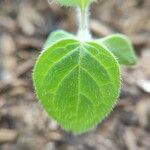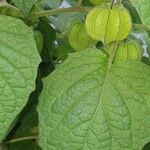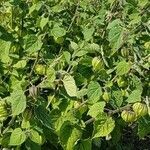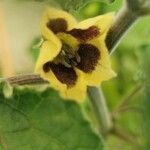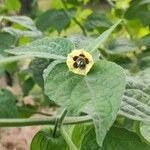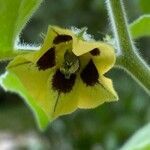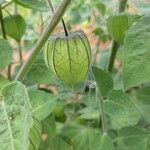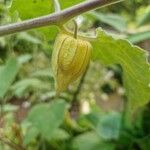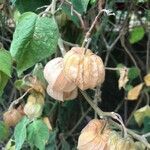Perennial herbs which grow to 45-90 cm high. They are often grown as annuals. It is only slightly branched but is hairy. The branches are purplish and ribbed. They are spreading. The leaf blade is 6-15 cm long by 4-10 cm wide. The leaves are heart shaped at the base and taper to the tip. They are slightly wavy and toothed along the edge. The flowers occur singly and hang down in the axils of leaves. The flowers are white with violet anthers and slightly spotted petals. The fruit is a berry 1-1.5 cm across. They are orange-yellow or pale brown. This is inside an inflated husk. The seeds are yellow and 2 mm across. There are several named cultivated varieties.
Corolla pale yellow or yellow, blotched with 5 ± dark violet, purplish or brownish markings strongly contrasting with the surrounding limb, sometimes continued by veins along the lobes, (9)10–15 mm long, sub-campanulate-rotate or campanulate, occasionally infundibular; tube subglabrous, on the inside with dense felted indumentum from near the insertion of the stamens to the mouth; limb (10)12–19(20) mm across, sublobed, widely spreading, on the outside with sparse, relatively long hairs on the parts not folded in bud, more dense and short at the apex and near the margins of the lobes, glabrous or subglabrous inside, densely ciliate.
Calyx 6–9(10) mm long, 4–6(7) mm across at the base of the lobes, cylindric to campanulate, sub-angled, truncate or invaginated at the base, densely villous, on the inside glabrous except for the lobes with ± dense, short indumentum towards the apex, near the margins and along the midrib; lobes subequal or unequal, 4–6 × 2–4.5 mm, ovate-triangular to lanceolate, acute or acuminate; in fruit dark yellow when ripe, sometimes with purplish base and venation, 30–40(50) × (20)25–30 mm, ovoid, 10-ribbed or slightly 10-angled, acuminate, half filled by the fruit, persistently hairy, the lobes up to 7–10 × 4–7 mm.
Annual or short-lived, sprawling or spreading perennial, (15)-20-150-(200) cm tall, densely hairy. Lvs petiolate. Lamina 5-16-(20) × 3-10-(17) cm, usually broadly ovate, entire or slightly sinuate-dentate; base subcordate or cordate; apex acuminate. Fls solitary. Calyx densely hairy outside; teeth 3-5 mm long, narrow-triangular, acuminate. Corolla 15-22 mm diam., pale yellow with purplish patch towards base; teeth very shallow, ± acute. Anthers 3-3.5 mm long, violet. Fruiting calyx 3-5 cm long, 10-ribbed, hairy. Berry 10-20 mm diam., orange; flesh sweet. Seed 1.5-2 mm diam., broadly oblong-ellipsoid.
Leaves solitary or geminate; petiole 0.5–5.5 cm long, rather sheathing at the base; lamina membranous or papyraceous, (2)3–16 × (1.5)2–11 cm, ovate-cordiform or ovate, often broadly so, occasionally subrotund, ± deltate or rhombic, base ± cordate to broadly cuneate, sometimes rounded or truncate, and often oblique or unequal-sided, apex acuminate or acute, ± entire to coarsely sinuate-dentate or dentate, the few teeth unequal, ± triangular, obtuse or acute, the sinuses rounded, ± densely clothed with somewhat appressed hairs, more abundant beneath and along the nerves and margins, densely ciliate.
Herbs perennial, 45-90 cm tall. Stems erect, sparingly branched, densely pubescent. Petiole 2-5 cm; leaf blade broadly ovate to cordate, 6-15 × 4-10 cm, densely pubescent, base cordate, margin entire or with a few indistinct teeth, apex short acuminate. Pedicel ca. 1.5 cm. Calyx broadly campanulate, 7-9 mm. Corolla yellow, spotted in throat, 1.2-1.5 × 1.2-2 cm. Filaments and anthers blue-purple; anthers 3-4 mm long. Fruiting calyx green, ovoid, with 5-10 weak angles, 2.5-4 cm, pubescent. Berry yellow, 1-1.5 cm in diam. Seeds yellow, ca. 2 mm in diam. Fl. summer, fr. autumn.
Perennial herb, up to 1 m high, ± erect, much-branched, densely glandular-hairy. Leaves ovate to triangular, base cordate, up to 100 mm long, margins entire to coarsely toothed; petioles up to 60 mm long. Flowers solitary, axillary. Calyx 8 mm long, 10-veined, lobes ± triangular. Corolla campanulate, up to 15 mm long, lobed, yellow, centre purple-spotted. Flowering time Nov.-May. Fruit globose berries, 10-15 mm in diam., yellow, inside inflated calyx, up to 30 mm long. Seeds many, lenticular, 2.5 mm in diam., glabrous, brown, finely pitted.
Annual herb, 0.25-1.00 m high; glabrous or sparsely hairy. Leaves petiolate; blade ovate to narrowly ovate, 50-110 x 35-80 mm, margins deeply and irregularly incised-toothed to undulate-toothed; petioles up to 40 mm long. Flowers: solitary; anthers 1.0-2.5 mm long, bluish or violet; fruiting calyx 10-angled or 10-ribbed and nearly terete; corolla yellowish, sometimes with indistinct spots; Jul.-Oct. Fruit a globose berry, 10-20 mm in diameter, bright yellow to orange, accrescent calyx papery.
Erect or ascending, occasionally trailing or straggling, often ± robust and diffusely ± branched, suffruticose or herbaceous with perennial base, 0.3–2.5 m high, arising from a stout, woody, sometimes creeping rootstock, unpleasantly scented, sometimes tinged purple or mauve, ± densely clothed all over with simple, fine, multicellular, white or greyish to brownish, patent to appressed, often long, usually eglandular hairs.
Perennial herb, 0.3-1.0 m high, with dense indumentum. Leaves broadly ovate, acuminate, cordate at base (50-)70-110(-150) x 40-70(-90) mm, entire or irregularly dentate-sinuate, petiolate. Flowers solitary. Calyx enlarging and enclosing berry. Anthers 3.5-4.0 mm long, purple. Flowers yellow with 5 large dark purple spots at base of lobes.
Stamens included or slightly exserted, subequal; filaments purple, (2)3–4(4.5) mm long, filiform, attached to the corolla tube near the base, furnished with a few hairs; anthers bluish to purple-red, 3–4 mm long, oblong in outline, straight after anthesis.
Fruit green turning golden or yellow to orange when ripe, subsessile or with a gynobase up to c. 0.8 mm long on the invaginated base of the erect to pendulous calyx, 11–20 × 10–15 mm, ovoid, ellipsoid or ± globose.
With slender filaments, acuminate lvs, and deep purple-blue (instead of yellow to light blue) anthers, occasionally escapes from cult. in our range.
Flowers solitary, axillary, erect to nodding; pedicel (5)6–18 mm long, densely clothed with ± patent hairs, in fruit elongating to 23 mm.
Ovary 2–2.5 × 1.5–2 mm, ovoid or ± globose, glabrous; style purple, 6–8 mm long, filiform, straight or slightly curved upwards.
Seeds brownish, 2 × 1.5–1.8 mm, ovate to orbicular in outline, sometimes reniform, reticulate-foveate all over.
Erect perennial up to 3 ft. high, densely hairy, from a creeping rootstock.
Branches obsoletely angular to angular-ribbed, striate, drying sulcate.
Disk 0.3–0.4 mm high, fleshy, glabrous.
